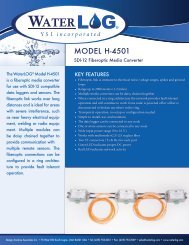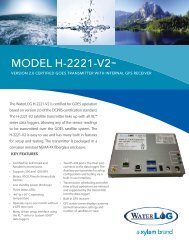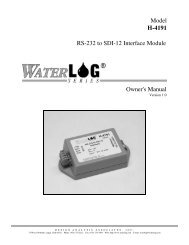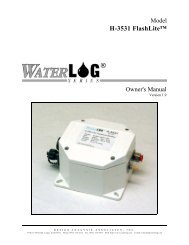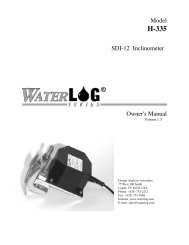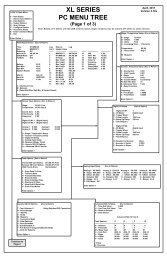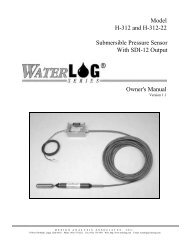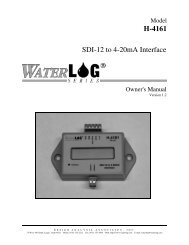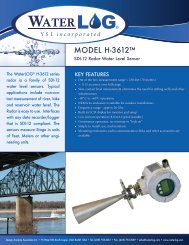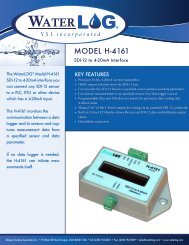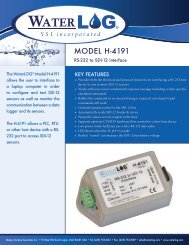You also want an ePaper? Increase the reach of your titles
YUMPU automatically turns print PDFs into web optimized ePapers that Google loves.
APPLICATION NOTE<br />
Title:<br />
Using XL-Series Data Loggers in <strong>Modbus</strong><br />
Networks<br />
Description: This document describes how to retrieve data<br />
from and send data to XL-series data loggers over<br />
a <strong>Modbus</strong> network.<br />
Product: H-350XL TM , H-500XL TM , H-510XL TM ,<br />
H-522XL TM , H-522+ TM<br />
Author: Kevin Goodsell<br />
Date: February 2005<br />
Revision: 0.4<br />
75 West 100 South<br />
Logan, UT 84321<br />
Tel: (435) 753-2212<br />
Fax: (435) 753-7669<br />
Internet: www.waterlog.com<br />
E-mail: waterlog@waterlog.com
1 General Information<br />
1.1 Introduction<br />
As of firmware version 2.02, an XL-series data logger can function as a slave (also known as a<br />
server) in a <strong>Modbus</strong> network. When used in this way, the data logger can respond to <strong>Modbus</strong><br />
requests by reporting back data values for any source that can normally be logged or transmitted.<br />
In order to prevent long delays in responding, some sources can optionally be queried for the<br />
“last known” value (usually the value at the last scan). Alternatively, a new value can be<br />
retrieved and sent with the response; however, in some cases this can cause a very long delay<br />
before the response is set. In cases where the time to retrieve a new value is known to be very<br />
short, a current value is always used.<br />
Certain options can also be set by writing to <strong>Modbus</strong> registers.<br />
1.2 <strong>Modbus</strong> Support<br />
1.2.1 Supported Modes of Operation<br />
An XL-series data logger can operate in either the <strong>Modbus</strong> RTU mode or the <strong>Modbus</strong> ASCII<br />
mode. Supported baud rates are 1200, 2400, 4800, 9600, and 19200. Parity can be set to Even,<br />
Odd, or None. In compliance with the <strong>Modbus</strong> specification, when parity is set to None, an extra<br />
stop bit is inserted. In RTU mode, 8 data bits are used. In ASCII mode, 7 data bits are used.<br />
1.2.2 Supported Functions<br />
The XL-series data loggers support the following <strong>Modbus</strong> functions:<br />
2 Configuration<br />
Read Coils<br />
Function Name<br />
Read Holding Registers<br />
Read Input Registers<br />
Write Single Coil<br />
2.1 Hardware Interface<br />
Write Single Register<br />
Write Multiple Coils<br />
Write Multiple Registers<br />
Function Code<br />
1 (0x01)<br />
3 (0x03)<br />
4 (0x04)<br />
5 (0x05)<br />
6 (0x06)<br />
15 (0x0F)<br />
16 (0x10)<br />
The data logger communicates on the <strong>Modbus</strong> network using the RS-232 port labeled RS-232 3.<br />
<strong>Modbus</strong> App. <strong>Note</strong> 1
2.2 Configuration Options<br />
<strong>Modbus</strong> configuration options can be found under Output Options -> <strong>Modbus</strong><br />
Options in the front-panel display menus. These options are also available through the<br />
terminal command and menu modes, but for simplicity this document will focus on the display<br />
menus. See Appendix B: Terminal Menus and Commands for details about accessing these<br />
settings from the terminal command and menu systems. Please note that the H-522XL does not<br />
include a front-panel display, so one of the terminal interfaces must be used.<br />
The following sections describe the options for configuring <strong>Modbus</strong> behavior.<br />
2.2.1 <strong>Modbus</strong> Mode<br />
The <strong>Modbus</strong> Mode option is used to enable or disable <strong>Modbus</strong> operation, and also to select<br />
between the RTU and ASCII <strong>Modbus</strong> modes. The options are Off, RTU, and ASCII.<br />
Because port RS-232 3 is also used for other functions (Remote Display, Auto Print, ALERT<br />
radios), setting the <strong>Modbus</strong> mode to Off when it is not being used is recommended in order to<br />
prevent conflicts.<br />
2.2.2 <strong>Modbus</strong> Address<br />
The <strong>Modbus</strong> Address option is used to set the slave address that the data logger will use on<br />
the <strong>Modbus</strong> network. Values from 1 to 247 can be used. The data logger will only respond to<br />
messages sent to this address.<br />
2.2.3 <strong>Modbus</strong> Baud<br />
The <strong>Modbus</strong> Baud option is used to set the communication baud rate. The options are 19200,<br />
9600, 4800, 2400, and 1200.<br />
<strong>Note</strong> that other functions that use port RS-232 3 do not respect the <strong>Modbus</strong> baud rate.<br />
2.2.4 <strong>Modbus</strong> Parity<br />
The <strong>Modbus</strong> Parity option is used to select what type of parity to use for serial<br />
communication. The options are None, Even, and Odd. When None is selected, an extra stop<br />
bit is transmitted instead of a parity bit.<br />
2.2.5 <strong>Modbus</strong> TimeOut<br />
The <strong>Modbus</strong> TimeOut option is used to select how long (in seconds) the data logger should<br />
stay on when no messages are being received. When this time expires the data logger enters a<br />
low power mode (unless something else prevents this, such as the front panel display being<br />
turned on). While in the low power mode, activity on the <strong>Modbus</strong> network will cause the data<br />
logger to turn back on. However, there is a short delay before it is fully on and able receive<br />
<strong>Modbus</strong> messages again. This will result in lost messages, so retransmissions may be required in<br />
this case.<br />
2 <strong>Modbus</strong> App. <strong>Note</strong>
Using a value of 0 for the timeout places the data logger in an “always on” mode. This prevents<br />
lost messages due to the wake delay, but it also prevents the logger from using its low power<br />
mode, resulting in higher power consumption.<br />
3 Data Formats and Addressing<br />
3.1 General <strong>Note</strong>s<br />
Most registers are grouped into pairs to create 32-bit values. Similar data can be retrieved from<br />
different addresses, with the choice of address determining the format of the data and (in some<br />
cases) whether the value should be measured prior to returning the result, or whether the last<br />
known value should be returned instead. The following table describes these options.<br />
Address Data Format New or Last<br />
Known Value<br />
0 to 249 32-bit IEEE single-precision floating point Last Known<br />
250 to 499 32-bit signed integer, calculated by multiplying the value by<br />
1000 then rounding to the nearest integer.<br />
500 to 749 32-bit IEEE single-precision floating point New<br />
750 to 999 32-bit signed integer, calculated by multiplying the value by<br />
1000 then rounding to the nearest integer.<br />
1000 and up Currently unused.<br />
Last Known<br />
There are a few exceptions. First, some sources are known to update very quickly, and therefore a<br />
new value is always used. Second, the time and date fields each occupy a single register and are<br />
not replicated at any other address.<br />
New<br />
Appendix A: Address Maps is provided as a quick reference for locating addresses.<br />
3.2 Coils<br />
Only coil addresses 0 through 2 are valid. Addresses 0 and 1 correspond to the two digital I/O<br />
ports on the XL-series data loggers. They can always be queried for the current state of the ports.<br />
They can also be set using the Write Single Coil or Write Multiple Coils functions (function<br />
codes 5 and 15, respectively); however, this operation is only valid when the port being set is<br />
configured for Triggered Continuous Output or Auto Continuous Output mode. A request to set a<br />
port that is configured for a different mode will result in exception 4 (Slave Device Failure).<br />
Coil address 2 corresponds to the switchable 12 volt excitation. This can always be queried for<br />
the current state, and it can also be written under certain circumstances. In order for a write to<br />
succeed, the XL series data logger must be revision N or newer, since the 12 volt excitation on<br />
earlier revisions was not switchable. Also, the 12 volt excitation must be set to either the Dflt.<br />
On or Dflt. Off (on by default or off by default) mode. If the write fails for any of these<br />
reasons, exception 4 (Slave Device Failure) is returned.<br />
<strong>Modbus</strong> App. <strong>Note</strong> 3
3.3 Input Registers<br />
Input registers are used for data sources other than functions, date, time, and digital inputs. This<br />
includes things like SDI-12 sensors, analog inputs, event counts, and system information such as<br />
battery voltage.<br />
3.4 Holding Registers<br />
Holding registers are used for time, date, and XL functions. Time and date are unusual because<br />
each field occupies only a single register. Addresses 0 through 5 correspond to the current year (2<br />
digits only), month, day of the month, hour (using a 24-hour clock), minute, and second, in that<br />
order. The current date and time can be set by writing to these registers.<br />
Writing all the time and date registers simultaneously is recommended to prevent errors resulting<br />
from the time (and possibly the date) unexpectedly updating just before the write takes effect. For<br />
example, suppose the clock is to be set back 2 seconds. The current time is 5:32:59. The current<br />
seconds value is read, 2 is subtracted, and 57 is written back to the seconds register. However,<br />
before this write takes place, the clock updates to 5:33:00. After the write, the clock reads<br />
5:33:57 instead of the intended time of 5:32:57.<br />
XL functions are also represented as holding registers. XL functions support reading both the<br />
most recently calculated value and a newly calculated value, and writing a new value. Writing a<br />
value completely replaces the previous function with a single constant value. This is useful if an<br />
application requires the XL-series data logger to log values supplied over the <strong>Modbus</strong> interface.<br />
When writing a new value to an XL function, the full 32-bit (2 register) value must be written.<br />
Writes that only cover one 16-bit register will result in an error. There is no such restriction on<br />
reading.<br />
Appendix A: Address Maps<br />
Coil addresses<br />
Source Coil Address <strong>Note</strong>s<br />
Digital I/O 1 0 (1)<br />
Digital I/O 2 1 (2)<br />
Always readable, only writable when configured for Continuous Output<br />
(Triggered or Auto).<br />
+12 Volt Excitation 2 (3) Only writable on revision N (or newer) data loggers, and only when 12<br />
volt excitation mode is Default On or Default Off.<br />
Input Register Addresses<br />
Source Stale Float Stale Int Fresh Float Fresh Int <strong>Note</strong>s<br />
Stage 0 (30001) 250 (30251) 500 (30501) 750 (30751) 1<br />
PSI 2 (30003) 252 (30253) 502 (30503) 752 (30753) 2<br />
PtTemp 4 (30005) 254 (30255) 504 (30505) 754 (30755) 2<br />
RemStg 6 (30007) 256 (30257) 506 (30507) 756 (30757)<br />
4 <strong>Modbus</strong> App. <strong>Note</strong>
Source Stale Float Stale Int Fresh Float Fresh Int <strong>Note</strong>s<br />
Counts 8 (30009) 258 (30259) 508 (30509) 758 (30759) 3<br />
TotCnt 10 (30011) 260 (30261) 510 (30511) 760 (30761) 3<br />
CtRate 12 (30013) 262 (30263) 512 (30513) 762 (30763) 3<br />
Ana1 14 (30015) 264 (30265) 514 (30515) 764 (30765)<br />
Ana2 16 (30017) 266 (30267) 516 (30517) 766 (30767)<br />
Ana3 18 (30019) 268 (30269) 518 (30519) 768 (30769)<br />
Ana4 20 (30021) 270 (30271) 520 (30521) 770 (30771)<br />
Freq 22 (30023) 272 (30273) 522 (30523) 772 (30773)<br />
Encodr 24 (30025) 274 (30275) 524 (30525) 774 (30775) 3<br />
Batt 26 (30027) 276 (30277) 526 (30527) 776 (30777) 3<br />
TScans 28 (30029) 278 (30279) 528 (30529) 778 (30779) 3<br />
Basic1 30 (30031) 280 (30281) 530 (30531) 780 (30781)<br />
Basic2 32 (30033) 282 (30283) 532 (30533) 782 (30783)<br />
Basic3 34 (30035) 284 (30285) 534 (30535) 784 (30785)<br />
Basic4 36 (30037) 286 (30287) 536 (30537) 786 (30787)<br />
Basic5 38 (30039) 288 (30289) 538 (30539) 788 (30789)<br />
SDI01 70 (30071) 320 (30321) 570 (30571) 820 (30821)<br />
SDI02 72 (30073) 322 (30323) 572 (30573) 822 (30823)<br />
SDI03 74 (30075) 324 (30325) 574 (30575) 824 (30825)<br />
SDI04 76 (30077) 326 (30327) 576 (30577) 826 (30827)<br />
SDI05 78 (30079) 328 (30329) 578 (30579) 828 (30829)<br />
SDI06 80 (30081) 330 (30331) 580 (30581) 830 (30831)<br />
SDI07 82 (30083) 332 (30333) 582 (30583) 832 (30833)<br />
SDI08 84 (30085) 334 (30335) 584 (30585) 834 (30835)<br />
SDI09 86 (30087) 336 (30337) 586 (30587) 836 (30837)<br />
SDI11 88 (30089) 338 (30339) 588 (30589) 838 (30839)<br />
SDI12 90 (30091) 340 (30341) 590 (30591) 840 (30841)<br />
SDI13 92 (30093) 342 (30343) 592 (30593) 842 (30843)<br />
SDI14 94 (30095) 344 (30345) 594 (30595) 844 (30845)<br />
SDI15 96 (30097) 346 (30347) 596 (30597) 846 (30847)<br />
SDI16 98 (30099) 348 (30349) 598 (30599) 848 (30849)<br />
SDI17 100 (30101) 350 (30351) 600 (30601) 850 (30851)<br />
SDI18 102 (30103) 352 (30353) 602 (30603) 852 (30853)<br />
SDI19 104 (30105) 354 (30355) 604 (30605) 854 (30855)<br />
SDI21 106 (30107) 356 (30357) 606 (30607) 856 (30857)<br />
SDI22 108 (30109) 358 (30359) 608 (30609) 858 (30859)<br />
SDI23 110 (30111) 360 (30361) 610 (30611) 860 (30861)<br />
SDI24 112 (30113) 362 (30363) 612 (30613) 862 (30863)<br />
SDI25 114 (30115) 364 (30365) 614 (30615) 864 (30865)<br />
SDI26 116 (30117) 366 (30367) 616 (30617) 866 (30867)<br />
<strong>Modbus</strong> App. <strong>Note</strong> 5
Source Stale Float Stale Int Fresh Float Fresh Int <strong>Note</strong>s<br />
SDI27 118 (30119) 368 (30369) 618 (30619) 868 (30869)<br />
SDI28 120 (30121) 370 (30371) 620 (30621) 870 (30871)<br />
SDI29 122 (30123) 372 (30373) 622 (30623) 872 (30873)<br />
SDI31 124 (30125) 374 (30375) 624 (30625) 874 (30875)<br />
SDI32 126 (30127) 376 (30377) 626 (30627) 876 (30877)<br />
SDI33 128 (30129) 378 (30379) 628 (30629) 878 (30879)<br />
SDI34 130 (30131) 380 (30381) 630 (30631) 880 (30881)<br />
SDI35 132 (30133) 382 (30383) 632 (30633) 882 (30883)<br />
SDI36 134 (30135) 384 (30385) 634 (30635) 884 (30885)<br />
SDI37 136 (30137) 386 (30387) 636 (30637) 886 (30887)<br />
SDI38 138 (30139) 388 (30389) 638 (30639) 888 (30889)<br />
SDI39 140 (30141) 390 (30391) 640 (30641) 890 (30891)<br />
SDI41 142 (30143) 392 (30393) 642 (30643) 892 (30893)<br />
SDI42 144 (30145) 394 (30395) 644 (30645) 894 (30895)<br />
SDI43 146 (30147) 396 (30397) 646 (30647) 896 (30897)<br />
SDI44 148 (30149) 398 (30399) 648 (30649) 898 (30899)<br />
SDI45 150 (30151) 400 (30401) 650 (30651) 900 (30901)<br />
SDI46 152 (30153) 402 (30403) 652 (30653) 902 (30903)<br />
SDI47 154 (30155) 404 (30405) 654 (30655) 904 (30905)<br />
SDI48 156 (30157) 406 (30407) 656 (30657) 906 (30907)<br />
SDI49 158 (30159) 408 (30409) 658 (30659) 908 (30909)<br />
SDI51 160 (30161) 410 (30411) 660 (30661) 910 (30911)<br />
SDI52 162 (30163) 412 (30413) 662 (30663) 912 (30913)<br />
SDI53 164 (30165) 414 (30415) 664 (30665) 914 (30915)<br />
SDI54 166 (30167) 416 (30417) 666 (30667) 916 (30917)<br />
SDI55 168 (30169) 418 (30419) 668 (30669) 918 (30919)<br />
SDI56 170 (30171) 420 (30421) 670 (30671) 920 (30921)<br />
SDI57 172 (30173) 422 (30423) 672 (30673) 922 (30923)<br />
SDI58 174 (30175) 424 (30425) 674 (30675) 924 (30925)<br />
SDI59 176 (30177) 426 (30427) 676 (30677) 926 (30927)<br />
SDI61 178 (30179) 428 (30429) 678 (30679) 928 (30929)<br />
SDI62 180 (30181) 430 (30431) 680 (30681) 930 (30931)<br />
SDI63 182 (30183) 432 (30433) 682 (30683) 932 (30933)<br />
SDI64 184 (30185) 434 (30435) 684 (30685) 934 (30935)<br />
SDI65 186 (30187) 436 (30437) 686 (30687) 936 (30937)<br />
SDI66 188 (30189) 438 (30439) 688 (30689) 938 (30939)<br />
SDI67 190 (30191) 440 (30441) 690 (30691) 940 (30941)<br />
SDI68 192 (30193) 442 (30443) 692 (30693) 942 (30943)<br />
SDI69 194 (30195) 444 (30445) 694 (30695) 944 (30945)<br />
SDI71 196 (30197) 446 (30447) 696 (30697) 946 (30947)<br />
6 <strong>Modbus</strong> App. <strong>Note</strong>
Source Stale Float Stale Int Fresh Float Fresh Int <strong>Note</strong>s<br />
SDI72 198 (30199) 448 (30449) 698 (30699) 948 (30949)<br />
SDI73 200 (30201) 450 (30451) 700 (30701) 950 (30951)<br />
SDI74 202 (30203) 452 (30453) 702 (30703) 952 (30953)<br />
SDI75 204 (30205) 454 (30455) 704 (30705) 954 (30955)<br />
SDI76 206 (30207) 456 (30457) 706 (30707) 956 (30957)<br />
SDI77 208 (30209) 458 (30459) 708 (30709) 958 (30959)<br />
SDI78 210 (30211) 460 (30461) 710 (30711) 960 (30961)<br />
SDI79 212 (30213) 462 (30463) 712 (30713) 962 (30963)<br />
SDI81 214 (30215) 464 (30465) 714 (30715) 964 (30965)<br />
SDI82 216 (30217) 466 (30467) 716 (30717) 966 (30967)<br />
SDI83 218 (30219) 468 (30469) 718 (30719) 968 (30969)<br />
SDI84 220 (30221) 470 (30471) 720 (30721) 970 (30971)<br />
SDI85 222 (30223) 472 (30473) 722 (30723) 972 (30973)<br />
SDI86 224 (30225) 474 (30475) 724 (30725) 974 (30975)<br />
SDI87 226 (30227) 476 (30477) 726 (30727) 976 (30977)<br />
SDI88 228 (30229) 478 (30479) 728 (30729) 978 (30979)<br />
SDI89 230 (30231) 480 (30481) 730 (30731) 980 (30981)<br />
SDI91 232 (30233) 482 (30483) 732 (30733) 982 (30983)<br />
SDI92 234 (30235) 484 (30485) 734 (30735) 984 (30985)<br />
SDI93 236 (30237) 486 (30487) 736 (30737) 986 (30987)<br />
SDI94 238 (30239) 488 (30489) 738 (30739) 988 (30989)<br />
SDI95 240 (30241) 490 (30491) 740 (30741) 990 (30991)<br />
SDI96 242 (30243) 492 (30493) 742 (30743) 992 (30993)<br />
SDI97 244 (30245) 494 (30495) 744 (30745) 994 (30995)<br />
SDI98 246 (30247) 496 (30497) 746 (30747) 996 (30997)<br />
SDI99 248 (30249) 498 (30499) 748 (30749) 998 (30999)<br />
<strong>Note</strong>s:<br />
1. Only available on the H-350XL and H-510XL.<br />
2. Only available on the H-350XL.<br />
3. Value is always updated, even for a stale read. Stale and fresh addresses are equivalent.<br />
Holding Register Addresses<br />
The following holding registers are 16-bit integers, rather than the usual 32-bit values.<br />
Source Address <strong>Note</strong>s<br />
Year 0 (40001) Years are stored as two digits. When writing, other digits are stripped off.<br />
Month 1 (40002)<br />
Day of Month 2 (40003)<br />
<strong>Modbus</strong> App. <strong>Note</strong> 7
Source Address <strong>Note</strong>s<br />
Hour 3 (40004) Based on a 24-hour clock.<br />
Minute 4 (40005)<br />
Second 5 (40006)<br />
The following holding registers can only be written as 32-bit values.<br />
Source Stale Float Stale Int Fresh Float Fresh Int<br />
FNT01 100 (40101) 350 (40351) 600 (40601) 850 (40851)<br />
FNT02 102 (40103) 352 (40353) 602 (40603) 852 (40853)<br />
FNT03 104 (40105) 354 (40355) 604 (40605) 854 (40855)<br />
FNT04 106 (40107) 356 (40357) 606 (40607) 856 (40857)<br />
FNT05 108 (40109) 358 (40359) 608 (40609) 858 (40859)<br />
FNT06 110 (40111) 360 (40361) 610 (40611) 860 (40861)<br />
FNT07 112 (40113) 362 (40363) 612 (40613) 862 (40863)<br />
FNT08 114 (40115) 364 (40365) 614 (40615) 864 (40865)<br />
FNT09 116 (40117) 366 (40367) 616 (40617) 866 (40867)<br />
FNT10 118 (40119) 368 (40369) 618 (40619) 868 (40869)<br />
FNT11 120 (40121) 370 (40371) 620 (40621) 870 (40871)<br />
FNT12 122 (40123) 372 (40373) 622 (40623) 872 (40873)<br />
FNT13 124 (40125) 374 (40375) 624 (40625) 874 (40875)<br />
FNT14 126 (40127) 376 (40377) 626 (40627) 876 (40877)<br />
FNT15 128 (40129) 378 (40379) 628 (40629) 878 (40879)<br />
FNT16 130 (40131) 380 (40381) 630 (40631) 880 (40881)<br />
FNT17 132 (40133) 382 (40383) 632 (40633) 882 (40883)<br />
FNT18 134 (40135) 384 (40385) 634 (40635) 884 (40885)<br />
FNT19 136 (40137) 386 (40387) 636 (40637) 886 (40887)<br />
FNT20 138 (40139) 388 (40389) 638 (40639) 888 (40889)<br />
FNT21 140 (40141) 390 (40391) 640 (40641) 890 (40891)<br />
FNT22 142 (40143) 392 (40393) 642 (40643) 892 (40893)<br />
FNT23 144 (40145) 394 (40395) 644 (40645) 894 (40895)<br />
FNT24 146 (40147) 396 (40397) 646 (40647) 896 (40897)<br />
FNT25 148 (40149) 398 (40399) 648 (40649) 898 (40899)<br />
FNT26 150 (40151) 400 (40401) 650 (40651) 900 (40901)<br />
FNT27 152 (40153) 402 (40403) 652 (40653) 902 (40903)<br />
FNT28 154 (40155) 404 (40405) 654 (40655) 904 (40905)<br />
FNT29 156 (40157) 406 (40407) 656 (40657) 906 (40907)<br />
FNT30 158 (40159) 408 (40409) 658 (40659) 908 (40909)<br />
FNT31 160 (40161) 410 (40411) 660 (40661) 910 (40911)<br />
FNT32 162 (40163) 412 (40413) 662 (40663) 912 (40913)<br />
FNT33 164 (40165) 414 (40415) 664 (40665) 914 (40915)<br />
FNT34 166 (40167) 416 (40417) 666 (40667) 916 (40917)<br />
8 <strong>Modbus</strong> App. <strong>Note</strong>
Source Stale Float Stale Int Fresh Float Fresh Int<br />
FNT35 168 (40169) 418 (40419) 668 (40669) 918 (40919)<br />
FNT36 170 (40171) 420 (40421) 670 (40671) 920 (40921)<br />
FNT37 172 (40173) 422 (40423) 672 (40673) 922 (40923)<br />
FNT38 174 (40175) 424 (40425) 674 (40675) 924 (40925)<br />
FNT39 176 (40177) 426 (40427) 676 (40677) 926 (40927)<br />
FNT40 178 (40179) 428 (40429) 678 (40679) 928 (40929)<br />
Appendix B: Terminal Menus and Commands<br />
This appendix describes how to configure <strong>Modbus</strong> options using the Menu and Command modes<br />
that are available through a terminal connected to the port labeled RS-232 1.<br />
Menus<br />
The <strong>Modbus</strong> settings are located under the Output Options menu, in the <strong>Modbus</strong> Out<br />
Options sub-menu. These menu items are nearly identical to those found in the front panel<br />
display menus.<br />
Commands<br />
The terminal commands that correspond to menu options used in this <strong>Application</strong> <strong>Note</strong> are<br />
described in the following table. Commands should be immediately followed by a question mark<br />
to print the current setting, or immediately followed by an equals sign and a new value to change<br />
the setting.<br />
Menu Option<br />
<strong>Modbus</strong> Mode<br />
<strong>Modbus</strong> Address<br />
<strong>Modbus</strong> Baud<br />
<strong>Modbus</strong> Parity<br />
<strong>Modbus</strong> TimeOut<br />
Command<br />
MODBUSMODE<br />
MODBUSADDRESS<br />
MODBUSSBAUDRATE<br />
MODBUSPARITY<br />
MODBUSTIMEOUT<br />
<strong>Modbus</strong> App. <strong>Note</strong> 9




